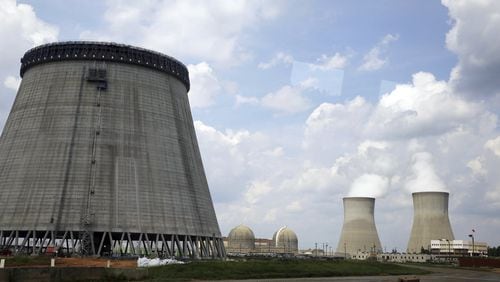A decision on what to do with Plant Vogtle’s half-built reactors could be made Friday, the expiration date for Georgia Power’s agreement that has kept work going at the site after a key contractor’s bankruptcy filing seven weeks ago.
But the Atlanta utility could seek another extension of the deal with the contractor, Westinghouse Electric as it tries to figure out what to do. Georgia Power has said it is considering all options for the $20 billion nuclear expansion, ranging from completing construction to shutting it down.
Georgia Power and Westinghouse “will continue to work on finalizing a new service agreement that would, if necessary, assure that Westinghouse continues to provide design, engineering and procurement services …,” Georgia Power spokesman John Kraft said in an email.
Southern Co., Georgia Power’s parent, is also seeking $3.7 billion from Westinghouse’s parent company, Toshiba Corp., as part of contract guarantees to finish the job.
But according to published reports, business partners are now preparing for a potential bankruptcy filing by Tokyo-based Toshiba itself, adding another layer of uncertainty to the increasingly tangled nuclear project.
Kraft said, “We will take every action available to hold Westinghouse and Toshiba accountable for their financial responsibilities under the (agreement) … and the parent guarantee.”
The effort to add two new reactors at Plant Vogtle, near Augusta, is over three years behind schedule and more than $3 billion over budget. Westinghouse’s bankruptcy is likely to bring more delays and higher costs.
Georgia Power owns 45.7 percent of the Vogtle project, which is being partly financed by surcharges that add about $100 a year to residential customers’ bills. The rest of Vogtle is co-owned by Oglethorpe Power, MEAG Power and Dalton Utilities.
Westinghouse is the main construction contractor and designer of the two reactors being built at Vogtle and two more at another plant in South Carolina operated by SCANA Corp. Westinghouse said it filed bankruptcy largely due to losses on those two projects under contracts in which it assumed most of the risk for cost overruns.
Meanwhile, Vogtle expansion opponents are expected to push the Georgia Public Service Commission, which holds committee meetings Thursday, to order Georgia Power to mothball the project.
A coalition of groups critical of the project, including Nuclear Watch South and Atlanta Grandmothers for Peace, plan what they’ve billed as the “Not one more cent for Vogtle” press conference Thursday outside the PSC’s office near the Georgia Capitol.
“We feel like we’ve reached a critical juncture,” said Kurt Ebersbach, senior attorney at the Southern Environmental Law Center. “It really comes down to a question of costs.”
He said a study completed this week for the SELC shows that demand for electricity has grown much slower than Georgia Power projected when the Vogtle project was approved in 2009, because of slowed economic growth and more energy-efficient lights, appliances, houses and offices.
According to the SELC’s projections, no new reactors or other big power plants will be needed in Georgia before at least 2030.
“We just feel that throwing money at some huge project with no end in sight is less preferable,” he said, than investing in efficiency improvement programs for customers and large solar power farms, which can be built more quickly and cheaply than Vogtle.
Asked for a response, Kraft said, “We are in the process of completing a full-scale schedule and cost-to-complete assessment…. We will actively work with the Georgia (PSC) and the co-owners to determine the best path forward for customers.’
About the Author






